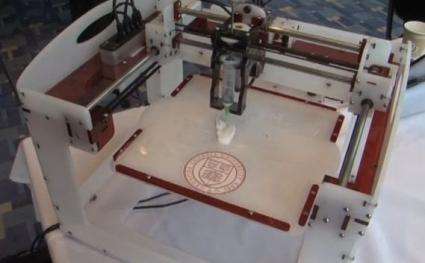February 24, 2011 report
3D bio-printers to print skin and body parts

(PhysOrg.com) -- The range of uses for three-dimensional printers is increasing all the time, but now scientists are developing 3D "bioprinters" that will be able to print out skin, cartilage, bone, and other body parts.
3D printers print by depositing material line by line and then vertically layer by layer. They have been used to make sculptures and repair sculptures, to make three-dimensional objects out of plastics and polymers, and even to print food.
Professor James Yoo, from the Institute of Regenerative Medicine at Wake Forest University in Winston-Salem, North Carolina told the annual meeting of the American Association for the Advancement of Science (AAAS) his group is developing a system that will allow them to print skin directly onto burn wounds.
Yoo’s team were motivated to develop a portable bioprinting system by the injuries arising on battlefields in Iraq and Afghanistan, where around 30 percent of injuries involve the skin. Their research is funded by the US Department of Defense.
The bioprinter has a built-in laser scanner that scans the wound and determines its depth and area. The scan is converted into three-dimensional digital images that enable the device to calculate how many layers of skin cells need to be printed on the wound to restore it to its original configuration. The system has successfully printed skin patches 10 cm square on a pig.
Also at the AAAS meeting was the director of Cornell University’s Computational Synthesis Laboratory, Professor Hod Lipson, who demonstrated a bioprinter by printing an ear, working from a scan of a human ear and a computer file containing the three-dimensional coordinates. The ear was printed using silicone gel instead of real human ear cells.
The Cornell team has already published results on their experiments to bioprint repairs to damaged animal bones, but Professor Lipson said there were a number of technical challenges still to overcome. He said the first use is likely to be repairs to cartilage, since it has a fairly simple internal structure with little vascularization.
Bioprinting cartilage has been tried "fairly successfully" in animal models, and the team have successfully printed cartilage cells directly into the meniscus of an injured knee to reconstruct it.
One of the major challenges to be faced in bioprinting is the connection between the bioprinted material and the rest of the body, especially with larger tissues, since any organ or body part that is printed will need to be connected to the body’s blood vessels, and this can be very difficult. Regardless of the challenges, Professor Lipson believes bioprinting will become a standard technique within a couple of decades.
© 2010 PhysOrg.com


















